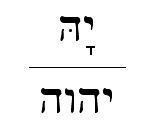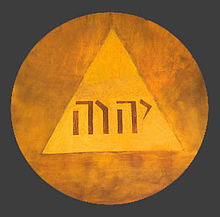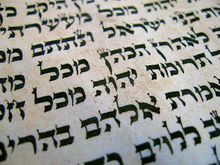Tetragrammaton
Appearance
(Redirected from YHWH)

The Tetragrammaton is the four-letter Hebrew theonym יהוה, the name of God in the Hebrew Bible. It is usually transliterated as YHWH. The four letters, written and read from right to left, are yodh, he, waw, and he. The pronunciation of the name is unknown. In English versions of the Bible, it is conventionally translated as "Lord". Observant Jews may use the terms "Adonai" ("my Lord") or "HaShem" ("the Name"), where the latter may be denoted in writing by the abbreviation ה׳. A short form of the name, ־יה, occurs at the end of the word "Hallelujah" (הַלְּלוּ־יָהּ), which means "praise יה" (or "praise the Lord").
Quotes
[edit]Hebrew Bible
[edit]

- אֵ֣לֶּה תוֹלְד֧וֹת הַשָּׁמַ֛יִם וְהָאָ֖רֶץ בְּהִבָּֽרְאָ֑ם בְּי֗וֹם עֲשׂ֛וֹת יְהֹוָ֥ה אֱלֹהִ֖ים אֶ֥רֶץ וְשָׁמָֽיִם׃ וְכֹ֣ל ׀ שִׂ֣יחַ הַשָּׂדֶ֗ה טֶ֚רֶם יִֽהְיֶ֣ה בָאָ֔רֶץ וְכׇל־עֵ֥שֶׂב הַשָּׂדֶ֖ה טֶ֣רֶם יִצְמָ֑ח כִּי֩ לֹ֨א הִמְטִ֜יר יְהֹוָ֤ה אֱלֹהִים֙ עַל־הָאָ֔רֶץ וְאָדָ֣ם אַ֔יִן לַֽעֲבֹ֖ד אֶת־הָֽאֲדָמָֽה׃ וְאֵ֖ד יַֽעֲלֶ֣ה מִן־הָאָ֑רֶץ וְהִשְׁקָ֖ה אֶֽת־כׇּל־פְּנֵ֥י הָֽאֲדָמָֽה׃ וַיִּ֩יצֶר֩ יְהֹוָ֨ה אֱלֹהִ֜ים אֶת־הָֽאָדָ֗ם עָפָר֙ מִן־הָ֣אֲדָמָ֔ה וַיִּפַּ֥ח בְּאַפָּ֖יו נִשְׁמַ֣ת חַיִּ֑ים וַֽיְהִ֥י הָֽאָדָ֖ם לְנֶ֥פֶשׁ חַיָּֽה׃
- Genesis 2:4–7
- Translations:
- Such is the story of heaven and earth when they were created. When God יהוה made earth and heaven—when no shrub of the field was yet on earth and no grasses of the field had yet sprouted, because God יהוה had not sent rain upon the earth and there were no human beings to till the soil, but a flow would well up from the ground and water the whole surface of the earth—God יהוה formed the Human from the soil's humus, blowing into his nostrils the breath of life: the Human became a living being.
- These are the generations of the heavens and of the earth when they were created, in the day that the Lord God made the earth and the heavens, and every plant of the field before it was in the earth, and every herb of the field before it grew: for the Lord God had not caused it to rain upon the earth, and there was not a man to till the ground. But there went up a mist from the earth, and watered the whole face of the ground. And the Lord God formed man of the dust of the ground, and breathed into his nostrils the breath of life; and man became a living soul.
- Comments:
- Genesis 2:4 contains the first occurrence of the name יהוה in the Bible. In previous verses, God is referred to as Elohim (אלהים).
- וּלְשֵׁ֤ת גַּם־הוּא֙ יֻלַּד־בֵּ֔ן וַיִּקְרָ֥א אֶת־שְׁמ֖וֹ אֱנ֑וֹשׁ אָ֣ז הוּחַ֔ל לִקְרֹ֖א בְּשֵׁ֥ם יְהֹוָֽה׃
- Genesis 4:26
- Translation:
- It was then that יהוה began to be invoked by name.

- וַיְדַבֵּ֥ר אֱלֹהִ֖ים אֶל־מֹשֶׁ֑ה וַיֹּ֥אמֶר אֵלָ֖יו אֲנִ֥י יְהֹוָֽה׃ וָאֵרָ֗א אֶל־אַבְרָהָ֛ם אֶל־יִצְחָ֥ק וְאֶֽל־יַעֲקֹ֖ב בְּאֵ֣ל שַׁדָּ֑י וּשְׁמִ֣י יְהֹוָ֔ה לֹ֥א נוֹדַ֖עְתִּי לָהֶֽם׃
- Exodus 6:2–3
- Translations:
- God spoke to Moses and said to him, "I am יהוה. I appeared to Abraham, Isaac, and Jacob as El Shaddai, but I did not make Myself known to them by My name יהוה."
- And God spake unto Moses, and said unto him, I am the Lord: And I appeared unto Abraham, unto Isaac, and unto Jacob, by the name of God Almighty, but by my name JEHOVAH was I not known to them.
- God also said to Moses, "I am the Lord. I appeared to Abraham, to Isaac and to Jacob as God Almighty, but by my name the Lord I did not make myself fully known to them."

- אָֽנֹכִ֖י֙ יְהֹוָ֣ה אֱלֹהֶ֑֔יךָ אֲשֶׁ֧ר הוֹצֵאתִ֛יךָ מֵאֶ֥רֶץ מִצְרַ֖יִם מִבֵּ֣֥ית עֲבָדִ֑͏ֽים׃ לֹֽ֣א־יִהְיֶ֥͏ֽה־לְךָ֛֩ אֱלֹהִ֥֨ים אֲחֵרִ֖֜ים עַל־פָּנָֽ͏ַ֗י׃
- Exodus 20:2–3
- Translation:
- I יהוה am your God who brought you out of the land of Egypt, the house of bondage: You shall have no other gods besides Me.
- Comments:
- Exodus 20:2–17 and Deuteronomy 5:6–21 relate the Ten Commandments.


- יְבָרֶכְךָ֥ יְהֹוָ֖ה וְיִשְׁמְרֶֽךָ׃
יָאֵ֨ר יְהֹוָ֧ה ׀ פָּנָ֛יו אֵלֶ֖יךָ וִֽיחֻנֶּֽךָּ׃
יִשָּׂ֨א יְהֹוָ֤ה ׀ פָּנָיו֙ אֵלֶ֔יךָ וְיָשֵׂ֥ם לְךָ֖ שָׁלֽוֹם׃- Numbers 6:24–26
- Translations:
- Comments:
- Recited as part of the Priestly Blessing, an important prayer in the Jewish faith. Also recited in Christian services.
- See also: Shema Yisrael


- שְׁמַ֖ע יִשְׂרָאֵ֑ל יְהֹוָ֥ה אֱלֹהֵ֖ינוּ יְהֹוָ֥ה אֶחָֽד
- Deuteronomy 6:4
- Transliteration:
- Translations:
- Comments:
- This is the Shema Yisrael prayer, the most important prayer in the Jewish faith. In Christianity, it is related to the Great Commandment.

- יְהֹוָ֤ה ׀ פֹּ֘קֵ֤חַ עִוְרִ֗ים
יְ֭הֹוָה זֹקֵ֣ף כְּפוּפִ֑ים
יְ֝הֹוָ֗ה אֹהֵ֥ב צַדִּיקִֽים׃- Psalms 146:8
- Translation:
Talmud
[edit]- הפותח ביו״ד וה״א וחותם ביו״ד וה״א הרי זה חכם באל״ף למ״ד וחותם ביו״ד וה״א ה״ז בינוני באל״ף למ״ד וחותם באל״ף למ״ד הרי זה בור ביו״ד וה״א וחותם באל״ף למ״ד הרי זו דרך אחרת.
- Tosefta Berakhot 6:26
- Translation:
- He who begins a prayer with the Tetragrammaton and ends with it is a scholar;
He who begins with Elohim and ends with the Tetragrammaton, is one of the average men;
He who begins with the Tetragrammaton and ends with Elohim, is an ignoramus;
He who begins with Elohim and ends with it is under suspicion of being a sectarian.- Louis Finkelstein: Pharisaism in the Making: Selected Essays, ch. 11, "The Development of the Amidah", pp. 250–251. Ktav Publishing House (1972). ISBN 0-87068-178-8.
- He who begins a prayer with the Tetragrammaton and ends with it is a scholar;
Quotes about the Tetragrammaton
[edit]
- We thus find that the entire Torah is a tapestry of the Name HaShem-יהו״ה. Because of this it is called, "Purely the Torah of HaShem–Torat HaShem Temimah–תורת יהו״ה תמימה." … You then will understand how great is the punishment of someone who mentions the name of heaven in vain; how much more so, someone who pronounces the name according to its letters; even more so, someone who makes use of it!
- Joseph ben Abraham Gikatilla: Sha'are Orah, "Introduction", 14–15. As translated in Gates of Light: A Translation and Adaptation into English of Shaarei Orah. Rabbi Amiram Markel and Rabbi Yehudah S. Markel. The Neirot Foundation (2023). ISBN 1-312-37183-8.
- When a man pronounces the Tetragrammaton, write the Cabalists, the nine heavens are shaken, and all the spirits cry out to each other: "Who thus disturbs the kingdom of heaven?" And then the earth reveals to the first heaven the sins of the foolhardy person who took the eternal one's name in vain, and the accusing Verb is transmitted from circle to circle, from star to star, and from hierarchy to hierarchy.
- Eliphas Levi: The Doctrine and Ritual of High Magic, ch. 3, "The Triangle of Solomon", p. 53. TarcherPerigee (2017). ISBN 0-14-311103-5.

- For non-Jews, the most familiar Name derived from the Hebrew Bible is probably Jehovah, a mistransliteration of the four-letter Name, Yud-Hay-Vav-Hay, the Tetragrammaton or, in Hebrew, the Shem Hameforash. This Name is actually never vocalized in Hebrew—it is too sacred, too powerful. … The Tetragrammaton is frequently shortened to Yah (Yud-Hey), Yahu or Yeho (Yod-Heh-Vav), especially when used in combination within names or phrases, as in Yehoshua (Joshua, meaning "the Lord is my Salvation"), Eliyahu (Elijah, meaning "my God is the Lord"), and Halleluyah ("praise the Lord").
- George Robinson: Essential Judaism: A Complete Guide to Beliefs, Customs, and Rituals, ch. 1, "Service of the Heart: Prayer and Ritual". Pocket Books (2000). ISBN 0-671-03481-2.
- It thus becomes possible to determine with a fair degree of certainty the historical pronunciation of the Tetragrammaton, the results agreeing with the statement of Ex. iii. 14, in which Yhwh terms Himself אהיה "I will be", a phrase which is immediately preceded by the fuller term "I will be that I will be", or, as in the English versions, "I am" and "I am that I am". The name יהוה is accordingly derived from the root הוה (= היה), and is regarded as an imperfect. This passage is decisive for the pronunciation "Yahweh"; for the etymology was undoubtedly based on the known word. The oldest exegetes, such as Onḳelos, and the Targumim of Jerusalem and pseudo-Jonathan regard "Ehyeh" and "Ehyeh asher Ehyeh" as the name of the Divinity, and accept the etymology of "hayah" = "to be" (comp. Samuel b. Meïr, commentary on Ex. iii. 14).
- Crawford Howell Toy and Ludwig Blau: "Tetragrammaton". Jewish Encyclopedia.

- The pronunciation of the Name was forbidden except to priests of the temple during the benediction of the people (Num. 6:22–7) and on the Day of Atonement, when the high priest spoke it ten times before the assembled worshippers (Lev. 16:30). Because unpointed Hebrew is composed entirely of consonants, it was possible to write the name in the books of the Torah and yet still conceal its pronunciation. It appears as יהוה, which is transliterated into the Latin characters IHVH (sometimes YHWH or JHWH). But the name could not be written in Greek without revealing the way of saying it. Josephus was a priest and knew the correct pronunciation of the Name, but states in his Antiquities (II, 12, 4) that religion forbids him to divulge it. Philo calls the Name ineffable and says that it is lawful only for those whose ears and tongues are purified by wisdom to hear and utter it in a holy place—in other words, for priests in the temple.
- Donald Tyson: Tetragrammaton: The Secret to Evoking Angelic Powers and the Key to the Apocalypse, "Introduction", p. 1. Llewellyn Publications (1995). ISBN 1-56718-744-7.
- The letters יהוה YHVH of the Tetragrammaton are used to imply the whole gamut of the four elements. י Y as the creative function of the Archetypal Realm, is Fire the Chiah; the first ה H represents the Cup, the symbol of the passive character of the Creative World, and is Water the Neschamah; ו V is the Son, the active vice-regent of the Father, and is Air the Ruach; and the final H ה is the Nephesch; the passive receptive Earth, fructifying all things.
- Israel Regardie: A Garden of Pomegranates (Second Edition), ch. 6, "The Literal Qabalah", p. 113. Llewellyn Publications (1987). ISBN 0-87542-690-5.

- According to Ricius, world history may be divided into three stages based upon the names of God in the Bible. The first period was the natural period, where God reveals himself through the three-lettered divine name shaddai. Then there is the Torah period, where God reveals to Moses the divine name of four letters, the Tetragrammaton. In the final period of grace and redemption, God reveals the Tetragrammaton plus the letter shin, or the letter of the Logos (Christ), spelling yhswh, or the Kabbalistic name of Jesus. Thus, the name of Jesus, or the miraculous name, became the pronouncable name of the previously unpronouncable yhwh.
- Robert Wilkinson: Tetragrammaton: Western Christians and the Hebrew Name of God, p. 326. Boston: Brill (2015). ISBN 978-90-04-28462-3.
See also
[edit]- Digrammaton
- Ehyeh Asher Ehyeh
- El
- El Elyon
- El Shaddai
- Elohim
- Hallelujah
- Jah
- Jehovah
- Judaism
- Names of God
- Pentagrammaton
- Shema Yisrael
- Tanakh
- Trigrammaton
External links
[edit]- The Tetragrammaton on Sefaria.org



